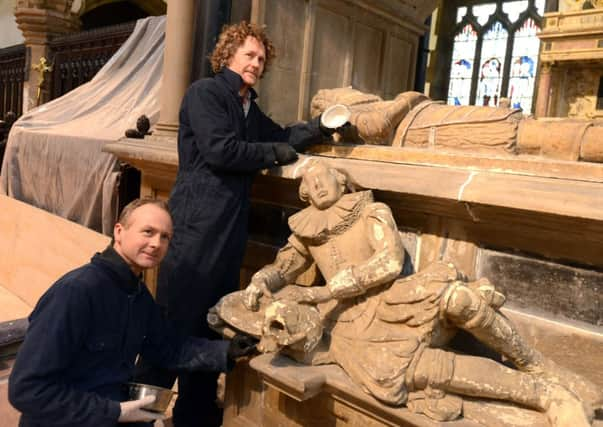Preserving the past of Thornhill


The parish church of St Michael and All Angels is treasure on our doorstep, teeming with history, art and culture and is described as one of the 1,000 best churches in the country in a book by chairman of the National Trust Simon Jenkins.
The church can be traced back as far as the 9th century and was mentioned in the Domesday Book in 1086. Five years ago timber figures from the church were sent to the Victoria and Albert Museum in London to be exhibited.
Advertisement
Hide AdAdvertisement
Hide AdLike many throughout the country, Thornhill’s historic church was struggling with a building in desperate need of repair until the creation of the Heritage Lottery Fund in the 1990s. But since then the fund, along with English Heritage, Churchcare and smaller bodies, has helped the church back on the road to recovery.
The latest work to be completed has been to monuments in the Savile Chapel. Since the 14th century, the church has been linked with the Savile family, who owned much of Kirklees.
Kieran Ryder conservators have been painstakingly conserving two of the most important monuments in the church, the tomb of Sir George Savile and his wife Anne, marked by a huge renaissance monument, and an alabaster effigy of a later Sir George.
Kieran Elliot of the conservation team, who has worked on projects in museums and churches throughout the country, said the work was tough but satisfying. “It’s very delicate, very heavy work. Some of the monuments here were in a perilous state” he added. “People tend to think of museums when they think of sculpture, but all the great sculptures are in parish churches.”
Advertisement
Hide AdAdvertisement
Hide AdLast week, scaffolding was removed from the tomb of Sir George and Lady Anne which dates from 1614. Around 18 months ago, the structure was deemed unsafe as it was beginning to collapse, forcing the adjoining walls apart and threatening the structural integrity of the west end of the church. The top of the monument had to be removed and around five tonnes of rubble removed from inside so the monument could be re-enforced by stainless steel beams. The sculptures of the couple themselves were then cleaned and protected for years to come.
Brian Pearson, former head of cultural services at Kirklees Council, has been overseeing works at the church over the years. He said: “The monuments themselves have not been restored, nothing has been added. They have been conserved for the future. What you see what you will have seen hundreds of years ago.”
Mr Elliot added: “We have to be very careful as the interventions we make are going to last for generations.”
He and his team also worked on the later monument to Sir George, dating from 1622, which is of national importance. The effigy was built by Maximillian Coulte, James I’s official sculptor, who also built the tomb of Elizabeth I.
Advertisement
Hide AdAdvertisement
Hide AdIt was held together with just seven fixings, including two animals bones – which Elliot Ryder were able to re-use.
“It looks just amazing,” said Mr Pearson. “You couldn’t see the detailed work before and the colours look fantastic.”
Mr Elliot added: “This church is a repository of amazing sculpture. Most churches would give anything just to have one of these.”
A replica of the stained glass window in the east window of the Savile Chapel to replace the deteriorated 15th century original was also made by conservator Jonathan Cooke last year. Other stunning windows in the building make up what is said to be one of the best collections of medieval glass outside of York Minster.
Advertisement
Hide AdAdvertisement
Hide AdWork on the path outside and the church roof has also been ongoing.
Thornhill Parish Church remains on English Heritage’s At Risk register, but Mr Pearson said a lot of the work had not been undertaken when the assessment was made. “A great deal has been done to deal with the issues. Being on the register is a reminder for us to keep an eye on the church.”
Work is now largely complete and Mr Pearson urged people to discover the history on their doorsteps. Interactive exhibitions have been installed to help people to engage with the church’s history.
“People come from all over the world to see the church. We’ve had people from Australia and New Zealand already this year.
Advertisement
Hide AdAdvertisement
Hide Ad“This is Dewsbury’s and Thornhill’s history. We’ve always been at the centre of the community. We just want people to come down and see what we’ve done. This is a local treasure.”
Visit www.thornhillparishchurchhistory.org.uk for more on the history and conservation work taking place.